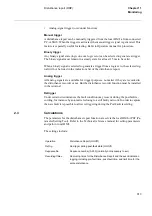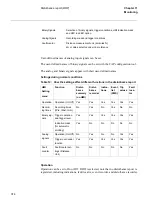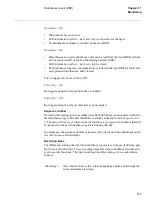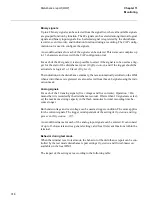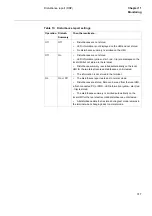
322
Disturbance recorder
&KDSWHU
0RQLWRULQJ
Similarly, if the average value is below the set threshold level for underfunction on the
channel in question, an underfunction start on that channel is indicated. The underfunc-
tion is indicated with a less than (<) sign.
The procedure is separately performed for each channel. This method of checking the
analog start conditions gives a function that is insensitive to DC offset in the signal. The
operating time for this start is typically in the range of one cycle, 20 ms in a 50 Hz net-
work.
The numerical data, along with the result of the trigger condition evaluation, are trans-
mitted to the main CPU. The main CPU handles these functions:
•
Evaluation of the manual start condition
•
Evaluation of the binary start condition, both for true binary input signals and for
internally created logical signals
•
Storage of the numerical values for the analog channels
The numerical data for the analog channels are stored in a cyclic pre-fault buffer in a
RAM. When a trigger is activated, the data storage is moved to another area in the
RAM, where the data for the fault and the subsequent post-fault period are stored. Thus,
a complete disturbance recording comprises the stored data for the pre-fault, fault, and
post-fault period.
The RAM area for temporary storage of recorded data is divided into sub-areas, one for
each recording. The size of a subarea is governed by the sum of the set pre-fault (tPre)
and maximum post-trigger (tLim) time. There is a sufficient memory capacity for at
least four consecutive recordings with a maximum number of analog channels recorded
and with maximum time settings. Should no such area be free at the time of a new trig-
ger, the oldest recording stored in the RAM is overwritten.
When a recording is completed, a post recording processing occurs.
This post-recording processing comprises:
•
Merging the data for analog channels with corresponding data for binary signals
stored in an event buffer
•
Compression of the data, which is performed without losing any data accuracy
•
Storing the compressed data in a non-volatile memory (flash memory)
The recorded disturbance is now ready for retrieval and evaluation. The recording com-
prises the stored and time-tagged disturbance data along with relevant data from the da-
tabase for configuration and parameter set-up.
Summary of Contents for REO 517
Page 10: ... RQWHQWV ...
Page 16: ...6 Introduction to the application manual KDSWHU QWURGXFWLRQ ...
Page 64: ...54 Blocking of signals during test KDSWHU RPPRQ IXQFWLRQV ...
Page 88: ...78 Scheme communication logic ZCOM KDSWHU LQH LPSHGDQFH ...
Page 146: ...136 Unbalance protection for capacitor banks TOCC KDSWHU XUUHQW ...
Page 166: ...156 Dead line detection DLD KDSWHU 3RZHU V VWHP VXSHUYLVLRQ ...
Page 378: ...368 Monitoring of DC analog measurements KDSWHU 0RQLWRULQJ ...
Page 384: ...374 Pulse counter logic PC KDSWHU 0HWHULQJ ...
Page 412: ...402 Serial communication modules SCM KDSWHU DWD FRPPXQLFDWLRQ ...
Page 440: ...430 LED indication module KDSWHU DUGZDUH PRGXOHV ...






